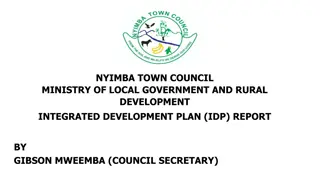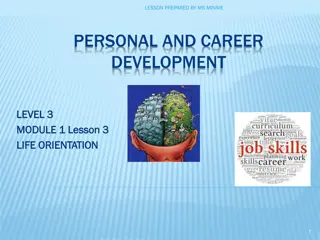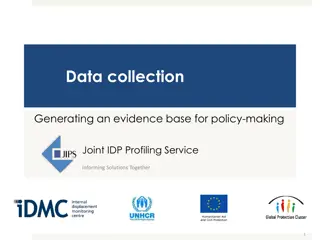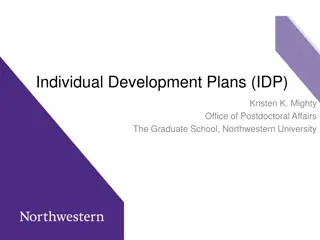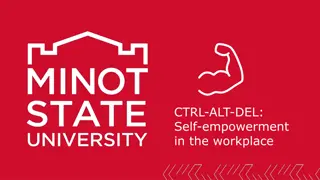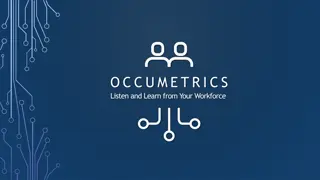Understanding Individual Development Plans (IDP) in the Workplace
Individual Development Plans (IDPs) are vital tools that facilitate employee growth and career advancement in organizations. They involve a collaborative process between employees and supervisors to identify goals, assess needs, and create a roadmap for skill development. Benefits include aligning employee goals with organizational objectives, tracking progress, and preparing for future roles. Key stakeholders such as employees, supervisors, mentors, and training coordinators play essential roles in the IDP process. Supervisors and mentors provide guidance and support, while employees take ownership of creating and updating their IDPs. Regular reassessment ensures alignment with changing job functions. Understanding the purpose, benefits, and roles involved in IDPs is essential for personal and organizational development.
Download Presentation

Please find below an Image/Link to download the presentation.
The content on the website is provided AS IS for your information and personal use only. It may not be sold, licensed, or shared on other websites without obtaining consent from the author. Download presentation by click this link. If you encounter any issues during the download, it is possible that the publisher has removed the file from their server.
E N D
Presentation Transcript
1 IDP Development Process June 2020 Dawn Fountain Training and Career Development Manager
2 What is an Individual Development Plan? The written process of needs and goals assessment of an individual in collaboration with a supervisor or manager
3 Benefits of Creating an IDP Gives employees, supervisors, and mentors an opportunity to establish objectives that support both the organization s and the employee s goals Provides a guide for working towards short & long-term career goals Serves as the basis for the divisions' training needs assessment and training plans Ability to track training progress
4 Purpose Reflect development needs for an employee s current position and future potential positions It can help: Identify training and other developmental experiences needed to achieve goals Improve performance in their current assignment Prepare for other assignments Prepare for increased responsibility Review it at least annually for: Assessment of skill needs Reassessment of goals It is important to reassess IDP when job function changes What skills are needed to succeed in the new job function
5 Who is Involved? Employees will determine goals and activities, create IDPs in SATERN, and update progress on activities. Supervisors will work with employees to evaluate skill gaps, development needs, and resources, and will review and approve the IDP. Mentors can be a good resource that can help with recommendations, insight, and comments on your development and IDP. Training Coordinator can be a resource to help provide you with guidance on completing your IDP and with development opportunities and options.
6 Development Roles Supervisor/Mentor - Create organization s vision - Define org-level Training & Development (T&D) needs - Set organizational goals - Define objectives for T&D - Learn employee s goals - Coach/Counsel Employees - Encourage T&D - Establish appropriate timing for T&D - Follow up after T&D - Provide feedback on progress Employee Training Coordinator - Perform Self-Evaluation - Division Development Support - Learn About GSFC Opportunities - Training Needs Analysis - Define T&D Goals - Individual Development Tools and Programs - Discuss Goals with Supervisor - Training & Developmental Opportunities - Develop Individual Development Plans - Develop Required Skills
7 IDP Process 1. Prepare Follow up mid-year Assess skill needs Track progress in SATERN Formulate goals Begin development activities Identify development activities 4. Manage 2. Create Approve IDP Revise IDP Create draft IDP on paper and Input into SATERN IDP Submit IDP Review IDP 3. Finalize
8 Phase 1 - Prepare Three Steps of the Prep Phase 1. Assess Skill Needs 2. Formulate Goals 3. Identify Development Activities
9 Step 1 Assess Skill Needs Begin assessing your skills and compare to those needed for your current job Examples of assessment methods: feedback surveys, performance appraisals, one-on-ones with customers, supervisor, co-workers, direct reports, or mentors List the skills and knowledge you need to enhance your performance Discuss which areas you should focus on with your supervisor
10 Step 2 - Formulate Goals Be SMART: Specific, Measurable, Action-Oriented, Realistic, and Time-Bound For each goal determine if: Short-Range - Goal you plan to achieve within the next year Often focus on development related to your current job assignment or technical/job specific skills needed now Mid-Range Goal you intend to achieve in 2-4 years Usually are development objectives important for growth within your present position or for developing a new skill or area of knowledge Long-Range Goal you wish to achieve in 5 years or more Often development goals that reflect career aspirations, taking on greater responsibility, or moving to a new area of work
11 Step 3 Identify Development Activities Opportunities for development can take on many forms For each of your development objectives, determine what strategies would best meet your needs Consider your learning style and timeframe
12 Examples of Development Activities Formal Training On-site classes (internal) Off-site classes (external) Academic Courses Conferences/Seminars/Workshops Specialized Training (courses brought on-site) Development Programs Self Study Books, videos, articles, & websites E-learning (Online courses through FAI, SATERN, DAU, etc.) One-on-One Development Mentoring Coaching On-the-Job Training Rotations Special Projects New Work Assignments Shadowing
13 Resources Available to Help Formulate IDPs 210 Training & Development Webpage: https://code200- external.gsfc.nasa.gov/210/content/employee-training- development OP Webpage: https://ooptechportal.hq.nasa.gov/Pages/CDTC.aspx SATERN: https://saterninfo.nasa.gov
14 Phase 2 - Create Create draft IDP on paper Input into SATERN IDP IDP Template: SATERN IDP Instructions: https://satern.nasa.gov/
15 Phase 3 - Finalize Revise any changes requested from Supervisor Review with Supervisor/Mentor Submit in SATERN Approve(d) by Supervisor
16 Phase 4 - Manage Begin Development Activities Track Progress Follow-up and discuss with Supervisor at least each 6 months





